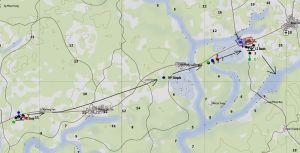Difference between revisions of "Air Assault for Pilots"
Views
Actions
Namespaces
Variants
Tools
Jester2138 (talk | contribs) |
Jester2138 (talk | contribs) |
||
| Line 5: | Line 5: | ||
''Pickup Zone:'' Where troops are picked up. | ''Pickup Zone:'' Where troops are picked up. | ||
''Release Point:'' Where helicopters begin their final approach to the LZ. Determines the azimuth of approach and all pilots should visualize what the LZ (and their part of it) will look like from the RP. | ''Release Point:'' Where helicopters begin their final approach to the LZ. Determines the azimuth of approach and all pilots should visualize what the LZ (and their part of it) will look like from the RP. Also marks the point-at-which pilots begin slowing down, and therefore should be 1-2km away from the LZ depending on the chopper type. | ||
''Landing Zone:'' Where troops are dropped-off. | ''Landing Zone:'' Where troops are dropped-off. | ||
Revision as of 02:12, 3 January 2020
AIR ASSAULT EXTREME BASICS:
There are three important geographical points: Pickup Zones (PZ), Release Points (RP), and Landing Zones (LZ).
Pickup Zone: Where troops are picked up.
Release Point: Where helicopters begin their final approach to the LZ. Determines the azimuth of approach and all pilots should visualize what the LZ (and their part of it) will look like from the RP. Also marks the point-at-which pilots begin slowing down, and therefore should be 1-2km away from the LZ depending on the chopper type.
Landing Zone: Where troops are dropped-off.
An Air Assault consists of moving a large number of troops rapidly from a PZ to an LZ, over an RP. There are two types of such lifts: formation and sequenced.
Formation lifts: When the entire group of helicopters lifts and lands together all at once in formation. The formation can be rough, and is determined by the desired layout of ground forces in the LZ. If Alpha needs to be on the left side of the LZ from the POV of the RP looking at the LZ, the chopper carrying Alpha needs to be on the left side of the formation. When landing in the PZ, choppers should arrange themselves in as similar formation to the LZ as possible, so nobody has to cross over/under another helicopter on the way - such movement is extremely dangerous.
For simplicity's sake, it's likely in the CCO we will not do any formation other than loose trail, with choppers joining up and breaking off to their specific point around LZ/PZs as needed.
In any case, the lead helicopter establishes the speed and navigates the group. He needs to be very situationally-aware. He also needs to fly at 50-70% of max speed to ensure everyone can catch up if-needed and maintain formation.
Sequenced lifts: When the helicopters take a specific interval in seconds and lift and land one-by-one following each other into the same LZ. 30 seconds is a good interval and results in each chopper having 5-7 seconds in the LZ before needing to takeoff and clear for the following chopper. Two things are critical to a sequenced lift: 1) each pilot honor the FULL time interval using the watch (press Oscar) and 2) each pilot fly the same speed on the way to the LZ. A rule-of-thumb can be to fly full speed and cut to idle at ~1.7km to the LZ, which will slow you down in time to land carefully with a little error margin. Yes, it actually can take that long to slow down in the Unsung Hueys.
Communication:
Standard radio concepts apply. You are identified by your callsign number, e.g. Ghost 1-3, and use that to refer to yourself. When in a flight with other helicopters, call out quickly and concisely what you are doing when taking-off and landing. Here are some examples:
Taking off, nobody nearby: "Ghost 1-3 lifting" Taking off with other helicopters on the ground nearby: e.g. "Ghost 1-3 lifting, passing overhead." When clear: "Ghost 1-3 clear." Landing: "Ghost 1-3 touchdown in LZ"
If, for example, only Ghost 1-1, 1-2, and 1-3 are involved in an operation, it can be appropriate to shorten your callsign to simply "1," "2," or "3," and say e.g. "3's lifting, passing overhead... 3's clear."


